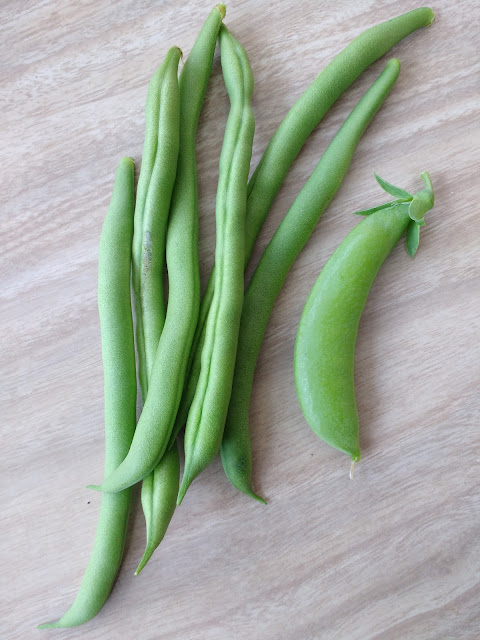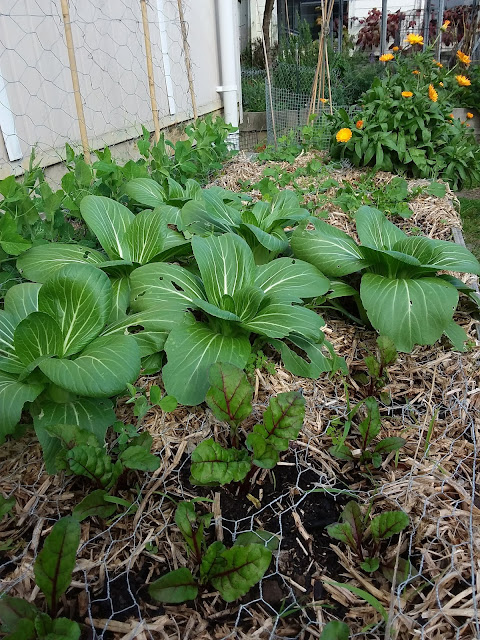Harvest
We are in the last weeks of Summer, by the astronomical calendar. Or the first days of Fall, by the meteorological calendar. The sound of cicadas has become ever present. Insects in general are out in force, including the ones that like to eat my veggies. I am reaching the peak of harvest for the tomatoes, and the beans are not far behind.
My growing-from-seed experiments have been a learning curve. I definitely learned the advantages of starting in a container or seed tray. The carrots and beans I started in seed trays - after the direct-sew seedlings got eaten to the ground by slugs - have been successful. I say "seed tray" but I have actually just been using small rectangular planter boxes, the type you might put in a window. The Koanga Gardens Growing Guide I read last Winter recommended seed trays significantly deeper than your typical seedling trays or pots: 7 to 10 cm deep depending on the seeds. I find these window planters are the right depth and a pretty convenient size for seed raising in small quantities. I've only got two of them, though, so I plan on getting a few more soon.
In fact I did an accidental experiment when planting out my beans: I grew some in newspaper seedling pots and some in a seed tray. They all did really well actually but the seed tray ones grew a little faster and started producing a little bit sooner.
I have been very happy with the seeds I ordered from Koanga Gardens online shop. The variety of beans are called Blue Lake, and one thing I appreciate is that they are climbers, but they aren't high climbers. My current trellises are made with 1.8cm poles; by the time I drive them into the ground they make trellis around 1.5cm high. That's plenty high in our weather, reducing the chance of them getting blown over in high winds. These beautiful little beans climbed well, but only one has even reached the top of the trellis. Instead, they put out plenty of secondary vines, and space their growing nodes a little closer together. What you end up with is a compact but very productive plant. The beans are also beautiful, tasty, and stringless.
Beautiful Blue Lake beans and one snap pea pod:
I'm happy with the courgette seeds I chose from Koanga as well. It turned out to be a variety that only grows monsters. By the time a courgette looks ready to pick, it's massive. These are beautiful stripey beasts - nicer to look at than the smooth little grocery store varieties. One of the fun things about growing your own veggies is that you get to try varieties you would never see in the grocery store.
This one is just over half a meter long:
I have learned one lesson well this year when it comes to courgette - and cucurbits in general: Never grow just one. With a lot of your fruiting veggies, pollination is pretty much a yes or no question. Either it got pollenated or it didn't. Some things might not grow as big if they are under-pollenated, but still just as edible. This is not the case with courgettes. If it is partially pollenated, you get these weird bits that don't grow very much, and those bits taste bad. I made the mistake of growing just one plant, an understandable mistake as the things take up a lot of space. But I've only gotten one fully pollenated courgette - the lovely specimen pictured above. And here is where more plants are better. Courgette - and all cucurbits - have separate male and female flowers. The more plants there are, the more male flowers that bee is likely to have visited before it gets to your female flower. While the phenomenon of bad underdeveloped spots is something I've only noticed in courgette and occasionally cucumber, there's a reason to grow more than one when it comes to your squash and pumpkins too.
With separate male and female flowers you run into another problem: what if a female flower opens on a day when no male flowers are available? This happens a lot in my experience, if you have just the one plant. The flowers are usually open for one or two days at most, so the timing has to be just right. Even if you have just one male flower, you need to then have a bee visit this specific flower before visiting the female. This was a problem with my butternut squash this year, which developed only one squash - and that one I took the time to hand pollenate after the first few flowers failed to pollenate. With more plants, you get more overall flowers, and a better shot at having male and female flowers open at the same time.
A last resort is hand pollenating. While it may sound like silly micro-managing of your vegetables, when you're talking about a plant that produces just a few large fruit, and you have just the one plant to fuss over, it can be worth the time. All you need is a small paint brush and a little patience. Do your best impression of a bumble bee and brush that pollen onto your brush, then transfer it onto the female flower. In all cucurbits you can tell which ones are females by the bit just below the flower that is basically a tiny version of whatever the veggie produces: a cucumber, a squash, and so on. I actually find this kind of thing fun - getting up close and gently brushing that bright yellow dusting of pollen onto the brush. But next year, I'm going to make sure I plant more than one. I've hand pollenated a few courgette this year, and they are still coming out a bit funny. Let's face it, the bees are just better at it.
I also got the latest run of carrots harvested yesterday with the help of my son. While my son has not been very interested in helping me in the garden this year, there is something about pulling root veggies out of the ground that children find irresistible. It's like a treasure hunt - who knows what lies beneath the surface? Will they be large or small? Perfectly symmetrical or comically misshapen? He pulled them all for me, then proudly posed for a picture before carefully cleaning them. They came out nice and fat but a little short, and most of them a little split at the ends. I did what I could to improve the soil in that bed but it there's clearly room for improvement.
What matters though is that they were delicious. Far sweeter than the ones I grew in a pot over Winter. The next lot of seedlings are already coming along in a seed tray and should be ready to plant out in a couple more weeks.
I've already got my mind on my Fall plantings. Carrot and rocket seedlings I started a few weeks ago. I'm planning lots of dark leafy greens this Winter, including mustard and collard greens. I already have a few silverbeet going that should continue through the Winter. I just got this lot of Fall seeds from Koanga Garden Centre last week:
I already started a few purple mustard seeds but they haven't come up yet. I will start on the collards next. Out here they are hard to come by in any form, and I note they are called "Dalmatian Cabbage" on the packet. Half my family is from the American South, so I'm looking forward to giving them a go.
I love how gardening continually connects me with the seasons. Here I am enjoying the late Summer harvest, recalling the Spring gardening work that got me here, and planning out my crops for the Fall and even Winter. I may be a little sad that Summer is nearly finished, but there's always something to look forward to in the garden.







Comments
Post a Comment